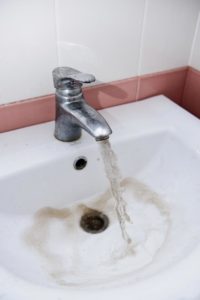Outside of the waste disposal industry and conservationists, nobody likes to think about garbage. As far as most are concerned, the sooner it disappears, the better everyone’s life is.
 A common method to dispose of garbage is, unsurprisingly, garbage disposal. In a 2004 study, 44% of all homes in America were found to have kitchen-sink unit garbage disposals.
A common method to dispose of garbage is, unsurprisingly, garbage disposal. In a 2004 study, 44% of all homes in America were found to have kitchen-sink unit garbage disposals.
The garbage disposal offers a quick and easy way to get rid of soft food garbage. Just as the garbage disposal can conveniently discard refuse, any issues about the structural integrity of the garbage disposal can make things worse.
Rather than getting rid of garbage, a leaking disposal unit means you’ll be liquid garbage leaking under your sink and, in severe cases, all over your floor.
Understand the Garbage Disposal
Garbage disposals are not complicated appliances. Mounted up on the kitchen sink, the refuse is entered into the disposal unit, which then feeds into a small trap that connects to the kitchen plumbing, eventually reaching the main line.
While every individual unit from each separate manufacturer will be different, this is the basic construction of a garbage disposal.
The simple construction of the garbage disposal is both good and bad news. In some regards, having so few parts means you should be able to detect more readily where a leak is coming from. On the other hand, with fewer and fewer parts to diagnose, the odds are always creeping up that some terminal issue exists within the actual disposal unit itself, meaning it will need to be replaced.
Some DIY Tips
 With so few components, there aren’t many areas to correct if there is some leak. That should reduce the amount of time it takes to check the actual unit.
With so few components, there aren’t many areas to correct if there is some leak. That should reduce the amount of time it takes to check the actual unit.
Here are a few places where the unit should be monitored.
- Check the unit’s connection to the physical sink.
- Tighten the fasteners that connect on each side of the trap.
- Test the unit to see if it is loose enough to move.
The disposal unit itself can work itself loose in a few separate areas over time, due to the vibrations it leaves in its wake while being operated. Check under the sink, first, to see if the brackets connecting the top elements to the sink are loose. The fasteners are usually screws, and they can be only turned to tighten: try to tighten these screws, bolts or fasteners and see if there is any give in them.
Another bit of maintenance is to tighten the fasteners between the unit, the trap and the sink line the trap connects to. (The trap is the pipe that connects from the disposal unit to the sink line.)
The fasteners for the trap are usually made of the same material the trap is: PVC traps will connect with PVC fasteners, cast-iron will have cast-iron, copper with copper, etc. Find both fasteners, the one that connects to the unit and the one that connects to the sink line, and gently try to tighten them. Don’t over do this, especially if they’re plastic: if you break either end of the trap or the sink-line, your maintenance effort will have caused a full-blown break in the line.
Another test you can perform is to attempt gently to rock the disposal unit. The unit should be firmly in place, and it should not move at all. If the unit is running, you should check every bracket, nut, and bolt until you find the offender. With luck, there isn’t anything structurally broken, or else you would need to replace broken parts or replace the whole unit.
IF you see a leak, you should run water in the sink to see where the water is leaking from. Usually, if you have tried the above methods and still cannot stop the unit from leaking, a professional should be called.
Problems You Should Call a Plumber For
The most common reasons a disposal unit would start leaking typically have very little to do with the unit itself.
One of the most common reasons a disposal unit begins to leak is that the unit itself is plugged, or the pipes from the unit are plugged. Liquid solutions are unlikely to work, in that case, as chemicals used to unclog pipes are more of a preventative measure than something that can fix the existing problem. A plumber should be contacted to break through the clog and get the water flowing properly through the pipes.
Disposal units may physically break in some measure – usually, a crack near the bottom or an o-ring used to seal the unit may either come loose or break. That does happen, but it is not as common as the pipes going bad.
 Cast iron pipes rust, and when they rust, they begin to rot away. The rust will sap the pipe of its structural strength until it becomes so degraded that it can no longer hold water.
Cast iron pipes rust, and when they rust, they begin to rot away. The rust will sap the pipe of its structural strength until it becomes so degraded that it can no longer hold water.
If that is the case, the pipes will need to be replaced immediately. There is no adequate short term fix for a pipe that is broken, so the leak will likely persist until a viable replacement can be found from a professional plumber.
Where those pipes begin to rot can be a major issue to consider. If the pipes are starting to fail behind the wall, it will become a major plumbing issue and crisis. Usually, though, the problem occurs between the trap and the connection where the disposal pipes connect to the sink line. This will require the trap to be disconnected from the disposal, the disposal unit removed (so that the pipes can be accessed) and the pipes to be removed and replaced.
That is a somewhat arduous task, so a professional should be hired to complete the job.
Conclusion
A little maintenance goes a long way, but maintenance alone won’t stave off old pipes or aged disposal units. Nothing is built to last forever.
Strongly consider contacting Daniel Cordova Plumbing, Drain & Sewer in West Covina, CA at (626) 962-0885 to come and inspect your garbage disposal unit as soon as you think there might be an issue.
 Prepare for UV Awareness Month
Prepare for UV Awareness Month
 Many people are aware they should have a new home inspected before buying, but often they fail to make sure the plumbing has been inspected as well. Months after the purchase, plumbing problems such as flooding and leaks start manifesting themselves.
Many people are aware they should have a new home inspected before buying, but often they fail to make sure the plumbing has been inspected as well. Months after the purchase, plumbing problems such as flooding and leaks start manifesting themselves. A plumber can provide guidance on estimating the cost of replacing lead pipes before you agree to buy the home. Other things that you should consider include:
A plumber can provide guidance on estimating the cost of replacing lead pipes before you agree to buy the home. Other things that you should consider include: Check for any warping or discoloration in the flooring, particularly around bathroom equipment. If the surface feels spongy, that is an indication there is a leak that requires repairs.
Check for any warping or discoloration in the flooring, particularly around bathroom equipment. If the surface feels spongy, that is an indication there is a leak that requires repairs.
 With so few components, there aren’t many areas to correct if there is some leak. That should reduce the amount of time it takes to check the actual unit.
With so few components, there aren’t many areas to correct if there is some leak. That should reduce the amount of time it takes to check the actual unit.